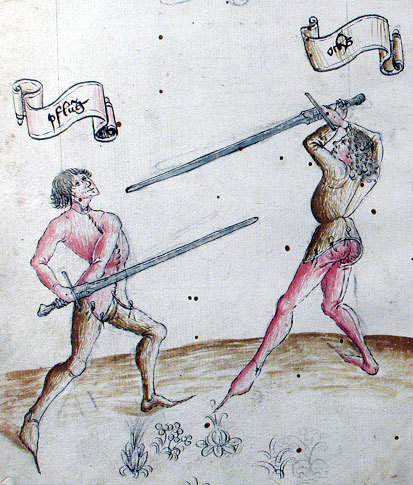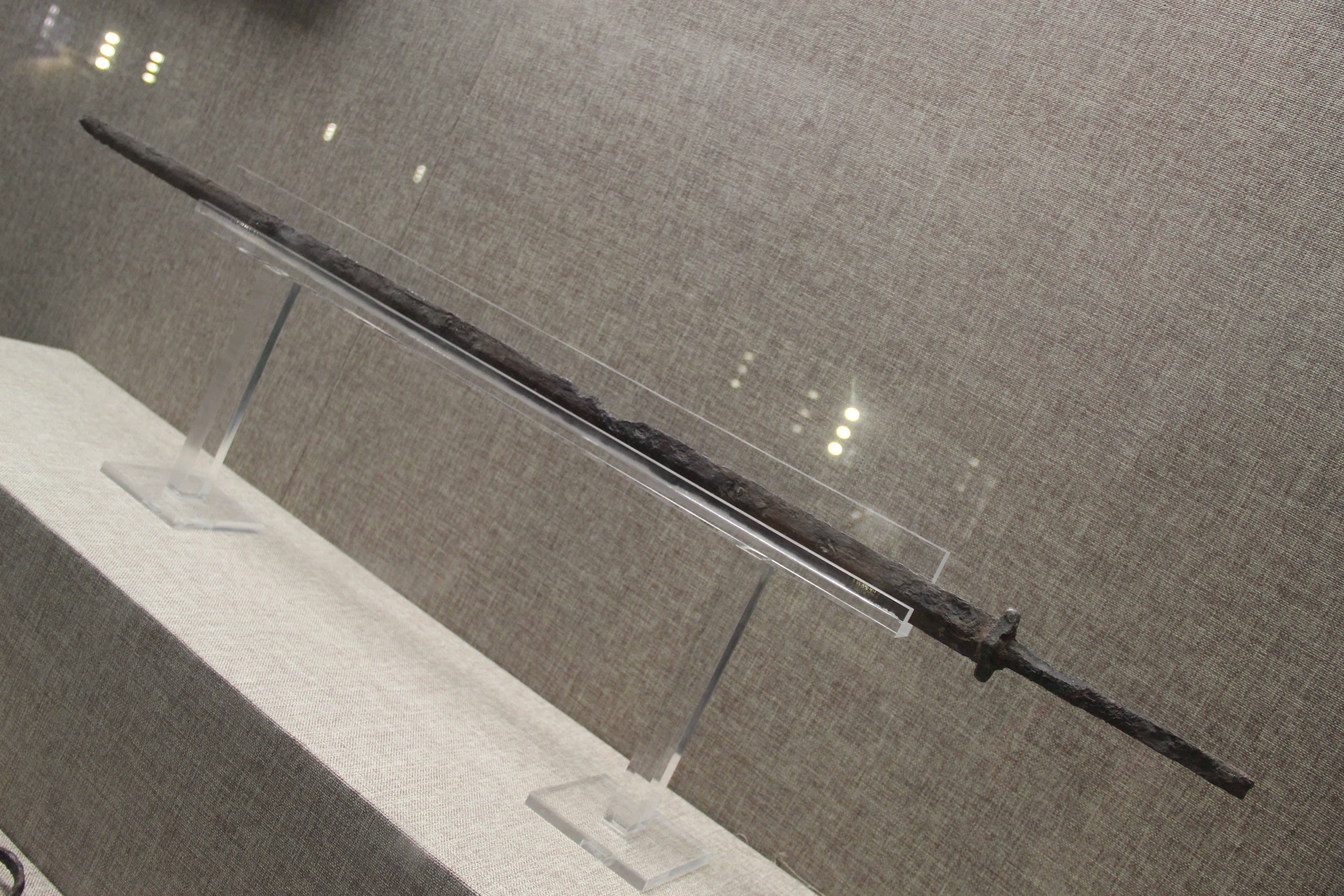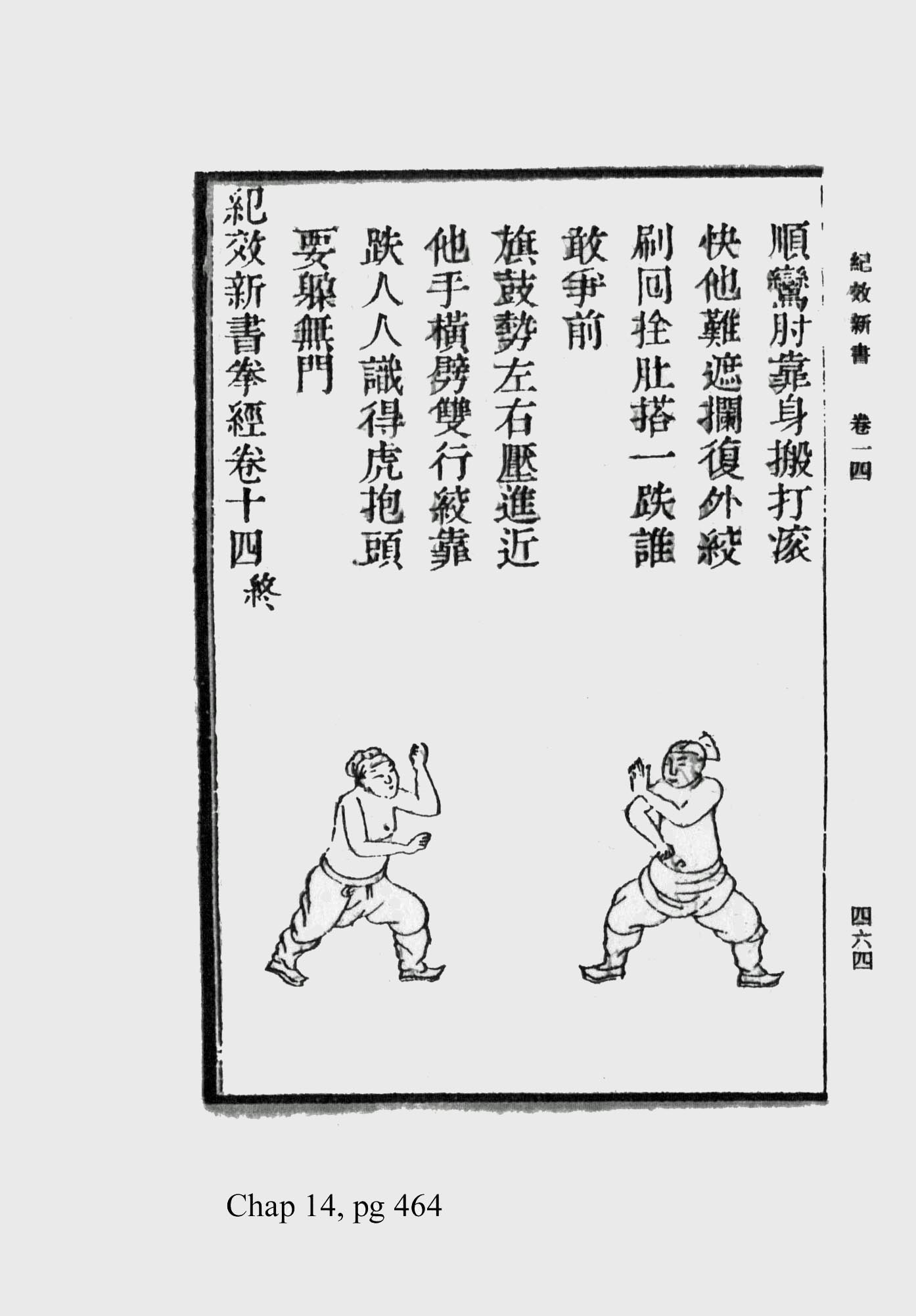|
Longsword
A longsword (also spelled as long sword or long-sword) is a type of European sword characterized as having a cruciform hilt with a grip for primarily two-handed use (around ), a straight double-edged blade of around , and weighing approximately . The "longsword" type exists in a morphological continuum with the medieval knightly sword and the Renaissance-era Zweihänder. It was prevalent during the late medieval and Renaissance periods (approximately 1350 to 1550), with early and late use reaching into the 12th and 17th centuries. Names English The longsword has many names in the English language, which, aside from variant spellings, include terms such as "bastard sword" and "hand-and-a-half sword." Of these, "bastard sword" is the oldest, its use being contemporaneous with the weapon's heyday. The French ' and the English "bastard sword" originate in the 15th or 16th century, originally in the general sense of "irregular sword, sword of uncertain origin", but by the mid ... [...More Info...] [...Related Items...] OR: [Wikipedia] [Google] [Baidu] |
German School Of Fencing
The German school of fencing (') is a system of combat taught in the Holy Roman Empire during the Late Medieval, German Renaissance, and Early Modern periods. It is described in the contemporary Fechtbücher ("fencing books") written at the time. The geographical center of this tradition was in what is now Southern Germany including Augsburg, Frankfurt, and Nuremberg. During the period in which it was taught, it was known as the ', or the ''"Art of Fighting"''. The German school of fencing focuses primarily on the use of the two-handed longsword; it also describes the use of many other weapons, including polearms, medieval daggers, messers (with or without a buckler), and the staff, as well as describing mounted combat and unarmed grappling (''ringen''). Most authors of writings on the system are, or claim to be, in the tradition of the 14th-century master Johannes Liechtenauer. The earliest surviving treatise on Liechtenauer's system is a manuscript dated to 1389, known a ... [...More Info...] [...Related Items...] OR: [Wikipedia] [Google] [Baidu] |
Historical Martial Arts Reconstruction
Historical European martial arts (HEMA) are martial arts of European origin, particularly using arts formerly practised, but having since died out or evolved into very different forms. While there is limited surviving documentation of the martial arts of classical antiquity (such as Greek wrestling or gladiatorial combat), surviving dedicated technical treatises or martial arts manuals date to the Late Middle Ages and the early modern period. For this reason, the focus of HEMA is ''de facto'' on the period of the half-millennium of ca. 1300 to 1800, with a German and an Italian school flowering in the Late Middle Ages and the Renaissance (14th to 16th centuries), followed by Spanish, Portuguese, French, English, and Scottish schools of fencing in the modern period (17th and 18th centuries). Arts of the 19th century such as classical fencing, and even early hybrid styles such as Bartitsu, may also be included in the term HEMA in a wider sense, as may traditional or folkloristi ... [...More Info...] [...Related Items...] OR: [Wikipedia] [Google] [Baidu] |
Sword
A sword is an edged, bladed weapon intended for manual cutting or thrusting. Its blade, longer than a knife or dagger, is attached to a hilt and can be straight or curved. A thrusting sword tends to have a straighter blade with a pointed tip. A slashing sword is more likely to be curved and to have a sharpened cutting edge on one or both sides of the blade. Many swords are designed for both thrusting and slashing. The precise definition of a sword varies by historical epoch and geographic region. Historically, the sword developed in the Bronze Age, evolving from the dagger; the earliest specimens date to about 1600 BC. The later Iron Age sword remained fairly short and without a crossguard. The spatha, as it developed in the Late Roman army, became the predecessor of the European sword of the Middle Ages, at first adopted as the Migration Period sword, and only in the High Middle Ages, developed into the classical arming sword with crossguard. The word '' sword'' continue ... [...More Info...] [...Related Items...] OR: [Wikipedia] [Google] [Baidu] |
Sword
A sword is an edged, bladed weapon intended for manual cutting or thrusting. Its blade, longer than a knife or dagger, is attached to a hilt and can be straight or curved. A thrusting sword tends to have a straighter blade with a pointed tip. A slashing sword is more likely to be curved and to have a sharpened cutting edge on one or both sides of the blade. Many swords are designed for both thrusting and slashing. The precise definition of a sword varies by historical epoch and geographic region. Historically, the sword developed in the Bronze Age, evolving from the dagger; the earliest specimens date to about 1600 BC. The later Iron Age sword remained fairly short and without a crossguard. The spatha, as it developed in the Late Roman army, became the predecessor of the European sword of the Middle Ages, at first adopted as the Migration Period sword, and only in the High Middle Ages, developed into the classical arming sword with crossguard. The word '' sword'' continue ... [...More Info...] [...Related Items...] OR: [Wikipedia] [Google] [Baidu] |
Knightly Sword
In the European High Middle Ages, the typical sword (sometimes academically categorized as the knightly sword, arming sword, or in full, knightly arming sword) was a straight, double-edged weapon with a single-handed, cruciform (i.e., cross-shaped) hilt and a blade length of about . This type is frequently depicted in period artwork, and numerous examples have been preserved archaeologically. The high medieval sword of the Romanesque period (10th to 13th centuries) developed gradually from the Viking sword of the 9th century. In the Late Medieval period (14th and 15th centuries), late forms of these swords continued to be used, but often as a sidearm, at that point called "arming swords" and contrasting with the two-handed, heavier longswords. Though the majority of late-medieval arming swords kept their blade properties from previous centuries, there are also surviving specimens from the 15th century that took the form of a late-medieval estoc, specialised for use against more ... [...More Info...] [...Related Items...] OR: [Wikipedia] [Google] [Baidu] |
Half-sword
Half-sword, in 14th- to 16th-century fencing with longswords, refers to the technique of gripping the central part of the sword blade with the left hand in order to execute more forceful thrusts against armoured and unarmoured opponents. The term is a translation of the original German ''Halbschwert''. The technique was also referred to as ''mit dem kurzen Schwert'', "with the shortened sword" in German. Half-sword is used for leverage advantage when wrestling with the sword, as well as for delivering a more accurate and powerful thrust. Both of these are critical when fighting in plate armour because a slice or a cleaving blow from a sword is virtually useless against iron or steel plate. Most medieval treatises show armoured combat as consisting primarily of fighting at the half-sword; the best options against an armoured man being a strong thrust into less-protected areas such as the armpits or throat or, even better, the same against a man who has already been cast to the gr ... [...More Info...] [...Related Items...] OR: [Wikipedia] [Google] [Baidu] |
Claymore
A claymore (; from gd, claidheamh- mòr, "great sword") is either the Scottish variant of the late medieval two-handed sword or the Scottish variant of the basket-hilted sword. The former is characterised as having a cross hilt of forward-sloping quillons with quatrefoil terminations and was in use from the 15th to 17th centuries. The weapon was also employed by the Irish and favoured by the mercenary Gallowglass in battle. The word ''claymore'' was first used in reference to basket-hilted swords during the 18th century in Scotland and parts of England. This description was maybe not used during the 17th century, when basket-hilted swords were the primary military swords across Europe, but these basket-hilted, broad-bladed, swords remained in service with officers of Scottish regiments into the 21st century. After the Acts of Union in 1707 when Scottish and English regiments were integrated together, the swords were seen as a mark of distinction by Scottish officers over the ... [...More Info...] [...Related Items...] OR: [Wikipedia] [Google] [Baidu] |
Scottish Gaelic Language
Scottish Gaelic ( gd, Gàidhlig ), also known as Scots Gaelic and Gaelic, is a Goidelic language (in the Celtic branch of the Indo-European language family) native to the Gaels of Scotland. As a Goidelic language, Scottish Gaelic, as well as both Irish and Manx, developed out of Old Irish. It became a distinct spoken language sometime in the 13th century in the Middle Irish period, although a common literary language was shared by the Gaels of both Ireland and Scotland until well into the 17th century. Most of modern Scotland was once Gaelic-speaking, as evidenced especially by Gaelic-language place names. In the 2011 census of Scotland, 57,375 people (1.1% of the Scottish population aged over 3 years old) reported being able to speak Gaelic, 1,275 fewer than in 2001. The highest percentages of Gaelic speakers were in the Outer Hebrides. Nevertheless, there is a language revival, and the number of speakers of the language under age 20 did not decrease between the 2001 and 20 ... [...More Info...] [...Related Items...] OR: [Wikipedia] [Google] [Baidu] |
Early Modern German
Early New High German (ENHG) is a term for the period in the history of the German language generally defined, following Wilhelm Scherer, as the period 1350 to 1650. The term is the standard translation of the German (Fnhd., Frnhd.), introduced by Scherer. The term ''Early Modern High German'' is also occasionally used for this period (but the abbreviation EMHG is generally used for '' Early Middle High German''). Periodisation The start and end dates of ENHG are, like all linguistic periodisations, somewhat arbitrary. In spite of many alternative suggestions, Scherer's dates still command widespread acceptance. Linguistically, the mid-14th century is marked by the phonological changes to the vowel system that characterise the modern standard language; the mid-17th sees the loss of status for regional forms of language, and the triumph of German over Latin as the dominant, and then sole, language for public discourse. Scherer's dates also have the merit of coinciding with two ... [...More Info...] [...Related Items...] OR: [Wikipedia] [Google] [Baidu] |
Fechtbuch
Martial arts manuals are instructions, with or without illustrations, specifically designed to be learnt from a book. Many books detailing specific techniques of martial arts are often erroneously called manuals but were written as treatises. Prose descriptions of martial arts techniques appear late within the history of literature, due to the inherent difficulties of describing a technique rather than just demonstrating it. The earliest extant manuscript on armed combat (as opposed to unarmed wrestling) is Royal Armouries Ms. I.33 ("I.33"), written in Franconia around 1300. Not within the scope of this article are books on military strategy such as Sun Tzu's ''The Art of War'' (before 100 BC) or Publius Flavius Vegetius Renatus' '' De Re Militari'' (4th century), or military technology, such as ''De rebus bellicis'' (4th to 5th century). Predecessors Some early testimonies of historical martial arts consist of series of images only. The earliest example is a fresco in tomb 1 ... [...More Info...] [...Related Items...] OR: [Wikipedia] [Google] [Baidu] |
Brescia
Brescia (, locally ; lmo, link=no, label= Lombard, Brèsa ; lat, Brixia; vec, Bressa) is a city and ''comune'' in the region of Lombardy, Northern Italy. It is situated at the foot of the Alps, a few kilometers from the lakes Garda and Iseo. With a population of more than 200,000, it is the second largest city in the administrative region and the fourth largest in northwest Italy. The urban area of Brescia extends beyond the administrative city limits and has a population of 672,822, while over 1.5 million people live in its metropolitan area. The city is the administrative capital of the Province of Brescia, one of the largest in Italy, with over 1,200,000 inhabitants. Founded over 3,200 years ago, Brescia (in antiquity Brixia) has been an important regional centre since pre-Roman times. Its old town contains the best-preserved Roman public buildings in northern Italy and numerous monuments, among these the medieval castle, the Old and New cathedral, the Renaissance ' ... [...More Info...] [...Related Items...] OR: [Wikipedia] [Google] [Baidu] |
Portuguese Language
Portuguese ( or, in full, ) is a western Romance language of the Indo-European language family, originating in the Iberian Peninsula of Europe. It is an official language of Portugal, Brazil, Cape Verde, Angola, Mozambique, Guinea-Bissau and São Tomé and Príncipe, while having co-official language status in East Timor, Equatorial Guinea, and Macau. A Portuguese-speaking person or nation is referred to as " Lusophone" (). As the result of expansion during colonial times, a cultural presence of Portuguese speakers is also found around the world. Portuguese is part of the Ibero-Romance group that evolved from several dialects of Vulgar Latin in the medieval Kingdom of Galicia and the County of Portugal, and has kept some Celtic phonology in its lexicon. With approximately 250 million native speakers and 24 million L2 (second language) speakers, Portuguese has approximately 274 million total speakers. It is usually listed as the sixth-most spoken language, the third-most sp ... [...More Info...] [...Related Items...] OR: [Wikipedia] [Google] [Baidu] |

_1r.jpg)


.jpg)




